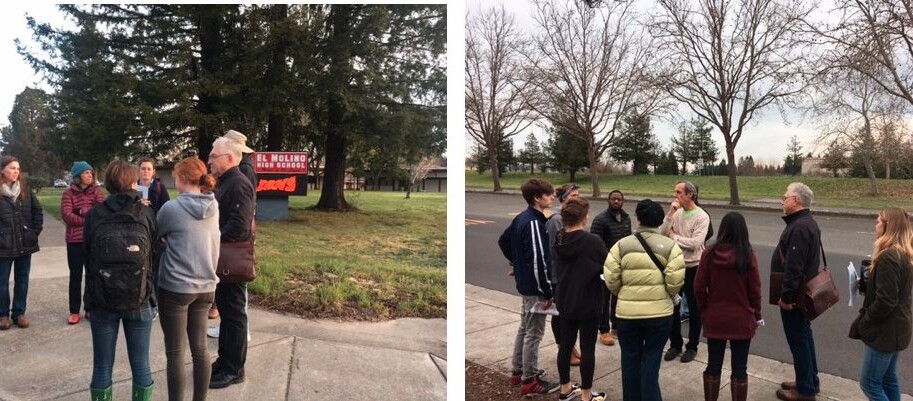“I learned that a long walk and calm conversation are an incredible combination if you want to build a bridge.”
-Seth Godin
At what stage would you feel comfortable sending your children walking or biking to school by themselves. My children are 7 and 4 years old now. We live 0.3 mile away from their elementary school and regularly walk to and from school together. On our way to school is Ducker Creek trail where we often stop by to notice when the ducks come and go or even just watch the ripples as we throw stones in the creek. It’s a pleasant walk for the most part but I certainly don’t feel ready to send them off on their own yet. How about when they are nine or ten, I wonder? Possibly, hopefully yes. There is a significant element of doubt and fear still. There are parts of this 0.3 mile stretch that feel unsafe either at the crossings or at points where cars occupy the pedestrian path for parking. Most of the street has a designated shoulder, where there are raised separators between the pedestrian path and the street. While this makes it quite reassuring, knowing how frantic traffic becomes during drop-off time near schools, it is hard to convince myself that people behind the wheel are truly mindful about walkers and bikers.
A 2010 report from the National Center for Safe Routes to School (SRTS) found that the barriers such as distance from school, traffic related dangers, weather, crime danger, and opposing school policy have remained the same but there has been about a 17% decline in children walking to and from school over a period of four decades, from 1969 to 2009.
It is such a conundrum that this should be the trend despite common sense and research all pointing to the benefits of maintaining an active lifestyle and developing these habits from a young age. It is critical then that children develop basic street skills starting young. An interesting documentary by Pascal Plisson made in 2013, “On the Way to School”, traces the journey from home to school for four kids from different parts of the world – Kenya, Morocco, Argentina and India. It puts into perspective the challenges we face in our communities around building a safe and accessible world for everyone.
At The Climate Center, the ECO2school program has been encouraging high school students to adopt transportation as a high-impact climate solution. For example, every student who chooses to walk or bike once a week for a year can save 100lbs of CO2. The program equips student leaders with the tools and confidence to coordinate campus transportation projects. In the process, these students are supported and empowered to be effective climate leaders and build active transportation habits for life that not only reduce their carbon footprints but also support healthy living, reduce traffic congestion and improve air quality for the entire community.
This year as part of an Active Transportation Planning grant ECO2school, in partnership with W-Trans, is conducting walk audits at eleven high school campuses around Sonoma County. The Walk Audit is a process that involves systematic gathering of information about environmental conditions around a school that impact students’ ability to walk or bike safely and easily to or from school. This information is gathered through a community process that encourages various community members to participate such as students, teachers, parents, school administration, as well as local police, city personnel, and community leaders. This data is shared with the public works departments to help drive improvements to the built infrastructure.
Schools receiving audits are: Analy High, El Molino, Credo, Windsor, Casa Grande, Healdsburg, Petaluma, Maria Carrillo, Piner, Santa Rosa High and Roseland University Prep. Analy, El Molino, Credo, and Windsor have completed their audits. This one hour intentional walk around the school campus with our “pedestrian and biker glasses” on, is an interesting experience. Often times the stakeholders at the audit end up learning new things about their neighborhood from each other, simply by being there and being part of the conversation. Here are some examples: At Windsor high school it was observed that there could be much better signage near the Vintana neighborhood leading into various bike paths, at Credo high school in Rohnert Park there was a need for a proper pathway from the SMART train station leading up to the school, at El Molino the crosswalks and sidewalks right outside the campus where there is high foot traffic were highly insufficient, at Analy high school the crosswalk on Sunset Ave behind the school campus did not make pedestrians feel safe. These challenges can be addressed with either minor infrastructure improvements or procedural changes that could significantly improve efficiency and safety conditions.
We invite you to participate in this process and share your comments and observations. Your input as local residents – people who know the area, who live or work there, and know what it’s like to walk around the neighborhood, is important to us. You know the challenges. This is your opportunity to have a voice in making improvements specifically around your school communities. To learn more about bike and pedestrian safety, ECO2school will be conducting community workshops as well that you can participate in.
Here is the audit schedule thus far.
- Casa Grande High School: Audit: 3/28 Community Meeting: TBD
- Petaluma High School: Audit: 04/04 Community Meeting: TBD
- Healdsburg High School: Audit: 04/11 Community Meeting: 04/23
- Piner High School: Audit: 04/18 Community Meeting: 04/25
- Maria Carillo High School: Audit: 04/25 Community Meeting: 04/19
- Santa Rosa High School: Audit: 04/02 (tentative) Community Meeting: TBD
- Roseland University Prep: Audit: 05/09 Community Meeting: 05/02
You can check for updates on this program on the ECO2school website at: http://www.eco2school.org/schools.html
For further details, please contact Maitreyi Siruguri at maitreyi[at]staging-theclimatecenter.org or 707-525-1665x:118.
This program is supported by funds from the California Department of Transportation Active Transportation Fund.


